Natural swimming pools (NSPs) garner interest in North America
by Sally Bouorm | March 1, 2013 11:55 am
 [1]
[1]By Lisa Brooks
A natural swimming pool (NSP) or pond is an engineered system comprising a contained swimming vessel and a constructed wetland. The constructed wetland may be integrated with or separated from the swimming vessel. Water purification and clarification is achieved entirely via the use of biological filters, hydroponically rooted aquatic plants, and the balanced ecosystem contained within the wetland, without the use of any chemicals or devices that disinfect or sterilize the pool water. For bather health and safety, the NSP optimizes the conditions found in nature’s water bodies.
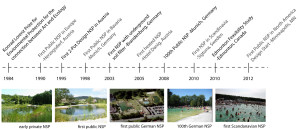 [2]
[2]NSPs have been in use in Europe since the early ’80s when Werner Gamerith, an Austrian engineer and environmentalist, together with his wife Tatjana, built one at their home in Austria. In 1984, the Gameriths were awarded the Konrad Lorenz Prize[3] for environmental protection, for the connection between art and ecology. This recognition captured the essence of the NSP.
From that time, a rapid rise in popularity occurred, which resulted in more than 20,000 residential NSPs being constructed in more than a dozen eastern and western European countries. Today, NSPs can be found throughout the world, including Canada, the United States, Australia, Brazil, Bulgaria, France, Luxembourg, Italy, Spain, Portugal, Holland, Sweden, Turkey, Israel, Austria, Croatia, Serbia, the Ukraine, Russia, England, and Mauritius.
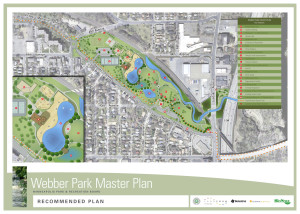 [4]
[4]Public/commercial NSPs have been in operation since 1990, with the first, also built in Austria, still being operated today. In Germany alone, there are more than 100 public NSPs in use.
North America’s first public NSP installation is currently being designed at Webber Park in Minneapolis[5], Minn., and is expected to open in spring 2014.
NSP element: The bathing zone
The contained swimming vessel is known as the bathing zone. It is isolated from soil, groundwater, and other structures by using a liner membrane, concrete, stainless steel, glass-reinforced plastic, or other impervious material. Among the various liner options are polyvinyl chloride (PVC), polyethylene (PE), flexible polyolefins (FPOs), and ethylene propylene diene monomer (EPDM).
 [6]
[6]Each material has positive features and usage challenges that can affect cost and functionality on a regional basis. For instance, EPDM is a vulcanized synthetic rubber that is durable and flexible even in cold weather conditions, but is more difficult to achieve wrinkle-free installations. Different forms of concrete, including shotcrete, gunite, and cement block construction are also suitable materials for NSP vessels. The choice of vessel construction is ultimately determined by local experience, preference, and pricing.
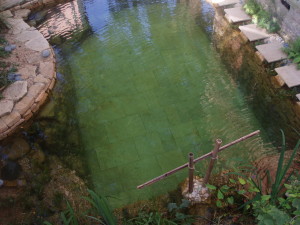 [7]
[7]The bathing zone can be finished in any material acceptable to the NSP owner and suitable for climate and pool use. Applied over the pool shell, natural stones, ceramic/glass tiles, and various waterproof and cementitious finishes are each compatible with NSP design and construction. In colder climates, material selection may be determined, in part, by durability and safety for winter sports.
Bathing zones can also include various elements for safety and accessibility, including depths, slopes, benches, steps, anti-entrapment devices, and all aspects for compliance with the Americans with Disabilities Act (ADA). Options for sport and recreation functionality, including lap and racing lanes, slides and waterfalls, beach entries, diving platforms, etc., are also available.
Maintaining the bathing zone is similar to what is required for a traditional chemical-treated pool. In addition to skimmers and overflow gutters, manual and/or robotic vacuums can be used to control surface debris and sediment. Further, brushing can also be performed, as desired, to eliminate biofilm that may form naturally on surfaces.
NSP element: The regeneration zone
The constructed wetland of an NSP is the regeneration zone. As with the bathing zone, it is a contained basin isolated by a liner or other form of shell construction. The finish material used in this zone is typically determined by the water garden design elements.
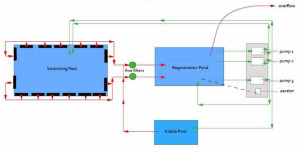 [8]
[8]In a residential NSP, the bathing and regeneration zones may be integrated, contiguous, or separated. When the two zones are integrated within a single contained vessel, they are isolated by internal separation wall(s) to manage and protect the planted water garden.
In public/commercial NSPs, it is typical to separate the regeneration zone by a distance appropriate to provide maximum plant protection and visitor safety.
Aquatic plants are selected based on suitability for the shallow, middle, and deep water areas, while ornamental plants can also be showcased as design elements. Maintenance of this zone is generally limited to seasonal tasks comparable to those for terrestrial gardens.
The goal of the regeneration zone is the permanent establishment of micro-organisms and other small life forms (e.g. zooplankton, which accomplish much of the water cleansing and clarification). This is living water, created by constructed optimization of nature’s processes.
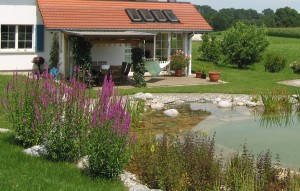 [9]
[9]The following illustration (Figure 14) summarizes the limnology of natural inland waters, as optimized in NSPs and ponds. The relationships of the plants (phytoplankton) and animals (zooplankton) are important to the clarity and purity of NSPs, as algae and other unwanted elements are consumed and removed from the water. Beneficial bacteria and microbes convert the byproducts of this consumption into nutrients for the rooted plants. Similarly, plant nutrients are created from the organic debris (e.g. skin cells, hair, sweat, body oils, cosmetics, lotions, etc.) introduced into the water from both the environment and bathers.
As a living ecosystem, the regeneration zone in an NSP also provides educational opportunities to learn about the ecosystem itself, the relationship of the ecosystem to the surrounding environment, and the choices available for greener manmade facilities.
Connecting the zones
Connecting the bathing and regeneration zones is achieved through hydraulic systems designed for optimum efficiency of the overall NSP ecosystem. Traditionally, water flows via gravity from the bathing zone through skimmers or overflow gutters and enters biological filtration equipment where larger particles are removed before the water is distributed through aggregate in the regeneration zone. Then, depending on the NSP’s size and design, the biologically cleansed water is returned to the bathing zone via plumbing and energy-efficient pump(s).
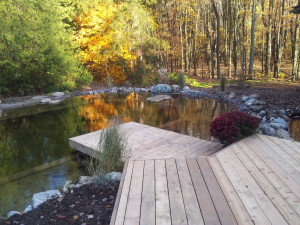 [10]
[10]Overall, NSPs operate efficiently and have minimal energy demands; however, by incorporating design elements such as waterfalls, slides, and fountains, additional energy may be required to circulate water through these elements.
The concepts and implementation of connection between the bathing and regeneration zones also allow for a traditional chemically treated pool to be converted to a NSP. The existing pool shell can be used and/or renovated and plumbed appropriately for a newly constructed regeneration zone, whether it is integrated into, or separate from, the bathing zone.
Regulatory considerations for NSPs
Traditional residential swimming pools in North America are typically regulated by local jurisdictions that monitor construction and safety elements. These controls i.e., plumbing, electrical, and construction requirements, would likely apply equally in the construction of a residential NSP. This is the typical approach throughout many of the countries in which NSPs have been installed.
In addition to regulations on construction, safety, and accessibility elements, traditional public/commercial swimming pools are typically subject to regulatory oversight of water quality and microbiological control. NSPs are not, by definition, sanitized pools, and are therefore appropriately regulated by different standards.
Most European Union (EU) countries have adopted the work of the German Landscape Research, Development and Construction Society (FLL), the organization that documents guidelines for the country’s ‘green’ industry. Guidance for private swimming and natural pools was developed in conjunction with the German Society for Semi-Natural Swimming Waters (DGfnB).
The FLL has documented recommendations for the planning, construction, and maintenance of private NSPs and for the planning, construction, servicing, and operation of public swimming and bathing pond facilities.
A residential NSP in Ontario
Last fall, St. Marys, Ont.-based John’s Pools and Ponds completed a residential NSP at an historic homestead. The clients specifically requested a chemical-free natural swimming experience in close proximity to local varieties of aquatic plants. This NSP was built utilizing a liner and a special separation wall technique to divide the swimming and regeneration zones.
In summary
NSPs/ponds offer chemical-free, low-energy, environmentally responsible and healthy living water for residential/commercial swimming facilities. They can incorporate all of the features of a current state-of-the-art pool design, including unlimited esthetics, accessibility, useful technologies, as well as sport and recreational functionality.
Further, NSPs provide educational and cultural enhancements, environmental benefits, and long-term financial value. They also provide a positive alternative that is currently garnering significant interest and appreciation throughout North America.
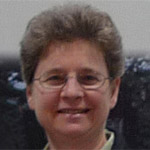 Lisa Brooks, PhD is a technical specialist, sciences, for BioNova® Natural Pools, a designer/builder of natural swimming pools (NSPs) based in Northern New Jersey. She has in-depth experience in chemistry, biology, and management having spent more than 20 years in the corporate world as a scientist, researcher, and manager. Brooks has an undergraduate degree in pathobiology from the University of Connecticut and a PhD in toxicology from UMDNJ Rutgers University. She joined BioNova in 2011 and is involved in the establishment of microbiological standards for natural swimming pools (NSPs) in North America. She can be reached via e-mail at lisa@bionovanaturalpools.com[11].
Lisa Brooks, PhD is a technical specialist, sciences, for BioNova® Natural Pools, a designer/builder of natural swimming pools (NSPs) based in Northern New Jersey. She has in-depth experience in chemistry, biology, and management having spent more than 20 years in the corporate world as a scientist, researcher, and manager. Brooks has an undergraduate degree in pathobiology from the University of Connecticut and a PhD in toxicology from UMDNJ Rutgers University. She joined BioNova in 2011 and is involved in the establishment of microbiological standards for natural swimming pools (NSPs) in North America. She can be reached via e-mail at lisa@bionovanaturalpools.com[11].
- [Image]: http://poolspamarketing.com/wp-content/uploads/2013/03/BioNova-13-Integrated-Zones-Hotel-Natural-Pool.jpg
- [Image]: http://www.poolspas.ca/wp-content/uploads/2015/05/BioNova-4-Selected-Historical-Milestones-Natural-Pools.jpg
- Konrad Lorenz Prize: http://creativecommons.org/licenses/by-sa/3.0/legal%20code
- [Image]: http://www.poolspas.ca/wp-content/uploads/2015/05/BioNova-5-Webber-Park-Master-Plan.jpg
- Webber Park in Minneapolis: http://www.tcdailyplanet.net/news/2012/09/03/new-future-webber-park-pool
- [Image]: http://www.poolspas.ca/wp-content/uploads/2015/05/BioNova-6-Natural-Pool-Construction-Nantucket-MA-cropped.jpg
- [Image]: http://www.poolspas.ca/wp-content/uploads/2015/05/BioNova-8-Natural-Pool-Bathing-Zone-Materials-2.jpg
- [Image]: http://www.poolspas.ca/wp-content/uploads/2015/05/BioNova-16-Schematic-Public-English.jpg
- [Image]: http://www.poolspas.ca/wp-content/uploads/2015/05/BioNova-12-Residential-Natural-Pool-Integrated-Zones.jpg
- [Image]: http://www.poolspas.ca/wp-content/uploads/2015/05/BioNova-18-Ontario-Natural-Pool.jpg
- lisa@bionovanaturalpools.com: mailto:lisa@bionovanaturalpools.com
Source URL: https://www.poolspamarketing.com/trade/natural-swimming-pools-nsps-garner-interest-in-north-america/